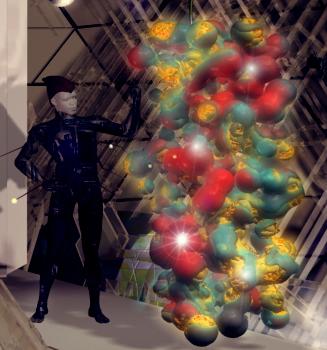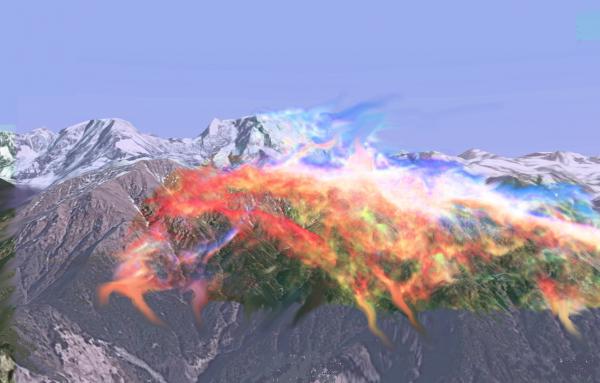BY LETTER
Nimbus
Galactography > Regions of Space > Inner Sphere
Sophonts > Modosophonts > Nanocyborg, Nanoborg
Galactography > Systems and Worlds > Systems & Worlds M - N
Sophonts > Modosophonts > Nanocyborg, Nanoborg
Galactography > Systems and Worlds > Systems & Worlds M - N
 Image from Juan Ochoa | |
| A sentient entity made of Utility Fog from Nimbus meets a nearbaseline human | |
Novoterra : 58 Eridani III
Novoterra - Nimbus - Data Panel | |
| System | 58 Eridani |
|---|---|
| Distance from Sol | 43.4 ly |
| Stellar Type | G1 V |
| Luminosity | 0.98 x Sol |
Former headquarters of Ubikorp. Currently centre of the Nimbus culture.
Ubikorp was one of the dominant megacorporations of the First Federation, installing nanotech systems across inhabited space. In 1716 it moved its headquarters to the Novoterra system where it set to terraform the planet Novoterra into a showpiece of nanotech macroengineering and integration. Unfortunately the company itself began to fall into disarray shortly afterwards due to conflicts between the various divisions, and in 1877 it split into 4 daughter megacorps. Novoterra became the focus of a serious of legal, physical and empathic struggles that ravaged it, and in 1898 all links to the system, including beamrider routes, were cut off.
While isolated Novoterra developed its own curious nanocyborg civilisation. Covering the partially terraformed planet was a dense layer of utility fog, a network of nanomachines that could both act as an information medium, transport things, perform intricate physical actions and modify the environment. A person connected to the fog could order it to do whatever was wanted, and it would happen - things could be materialised from thin "air", objects or people moved, 3D images seamlessly integrated with reality and temperature, pressure, air composition or visibility regulated (this was later implemented on Fata Morgana and many other worlds). The inhabitants used utility fog to serve and protect themselves, but over the years they developed more and more intricate interfaces, until they themselves existed mainly as programs running in the fog and showing visible projections rather than have fixed bodies.
When contact was restored in 2123, Novoterra - now called Nimbus - became a neutral part of the Empire. The inhabitants traded nanosolutions and utility fog with other worlds in exchange for nanotech templates, experiences and rare lifeforms. Their ships were filled with utility fog, easy to replicate from raw materials available in space. They set up several far-flung colonies/enclaves, although only a few have persisted. During the Version War it was instrumental in the restoration of the Inner Sphere, briefly becoming one of the major worlds of the Commonwealth before settling back into virtuality. Currently it is on the rise again, as many of the remote colonies want utility fog to get an edge in the growing competition, particularly the most advanced forms of hyperfog that Nimbus can supply.
Nimbus culture is very old and traditional. It has gone between a reality-oriented state and a virtual state where everything just exists as software many times, each time developing new quirks. Sometimes individual existence is popular, sometimes individuality merges into a diffuse mist consciousness. The nimbus people and AIs (if there is any difference) are known to be somewhat reluctant to engage in long- range politics just because they understand the transience of ideology, empires, religions or species. To them there is just an eternal flow of shape, neither to be accepted or denied, just experienced. Structures that survive for a long time are worth respect, and as Nimbus regards itself as constantly flowing it does not take itself entirely seriously.
Politically Nimbus is a minor player at present, but individual (if such a word can be applied) mists have occasionally made splashes in interstellar politics.
 Image from Steve Bowers | |
| Utility Fog self-replicating in the Yeyeos mountains on Escelon 3 | |
One of the most embarrassing cases was in 9745 when a number of dissidents were exiled to the remote Yeyeos mountains on Escelon 3 in the Puppis Democracy, where they set to quietly convert parts of the mountain range into utility foglets in order to take over the planet. When discovered a major nanotech war broke out on the surface, devastating 33% of the biosphere before the defenders could wipe out the fog. Nimbus apologised for the event but explained it could not claim more than 0.3% responsibility of it; the reparations were still a significant factor in the rebuilding of Escelon. Many people since then mistrust the Nimbus entities as being far too unpredictable to deal with.
Related Articles
Appears in Topics
Development Notes
Text by Anders Sandberg
Initially published on 23 July 2000.
Initially published on 23 July 2000.






